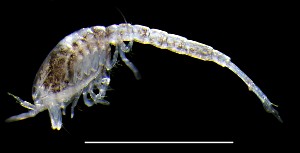
A new genus and species of bodotiid cumacean (commonly called hooded shrimp) has been discovered in tidal waters of the Maryland Coastal Bays thanks to researchers working through the National Science Foundation CREST Center for the Integrated Study of Coastal Ecosystem Processes and Dynamics at UMES. The microscopic crustacean was duly named Carinacuma umesi.
Dr. Andrés G. Morales-Núñez, a research assistant professor in the NSF CREST-CISCEP Center, made the discovery supported by Dr. Paulinus Chigbu, director of the center and director of the NOAA Living Marine Resources Cooperative Science Center at UMES.
“This is a significant contribution to knowledge of the biodiversity and zoogeography of crustaceans, particularly cumaceans, and underscores the need for additional studies on the taxonomy and ecology of benthic macroinvertebrates of the coastal waters of the northeastern United States,” Chigbu said.
The discovery derived from a more intensive fine sieving effort and careful examination of the marine invertebrates following a 2016 study the two were involved in, Morales-Núñez said. The new study included sediment samples collected and processed over a two-year period (2017-19) from 24 sites located in the St. Martin River and Chincoteague, Newport, Sinepuxent, Isle of Wight and Assawoman bays. The specimens were dissected and mounted on slides for observation so that drawings, photographs and measurements could be taken.

Cumaceans are small (1-35 mm) crustaceans from the superorder Peracarid that live in the sandy or muddy bottoms of brackish waters, nine species of which had previously been found in the Chesapeake Bay. The new species identified closely resembles Spilocuma watling, which is native to the northeast Gulf of Mexico, but differs in that the males lack pleopods (swimming legs). Type material (the specimens that serve as exemplars for the species) has been deposited in the Smithsonian Institution’s National Museum of Natural History in Washington, D.C.
The article on this work was published August 24 in the PeerJ (DOI 10.7717/peerj.11740) according to the International Commission on Zoological Nomenclature and has been registered in ZooBank, the online registration system for the ICZN.
Gail Stephens, agricultural communications, University of Maryland Eastern Shore, School of Agricultural and Natural Sciences, gcstphens@umes.edu, 410-621-3850.

